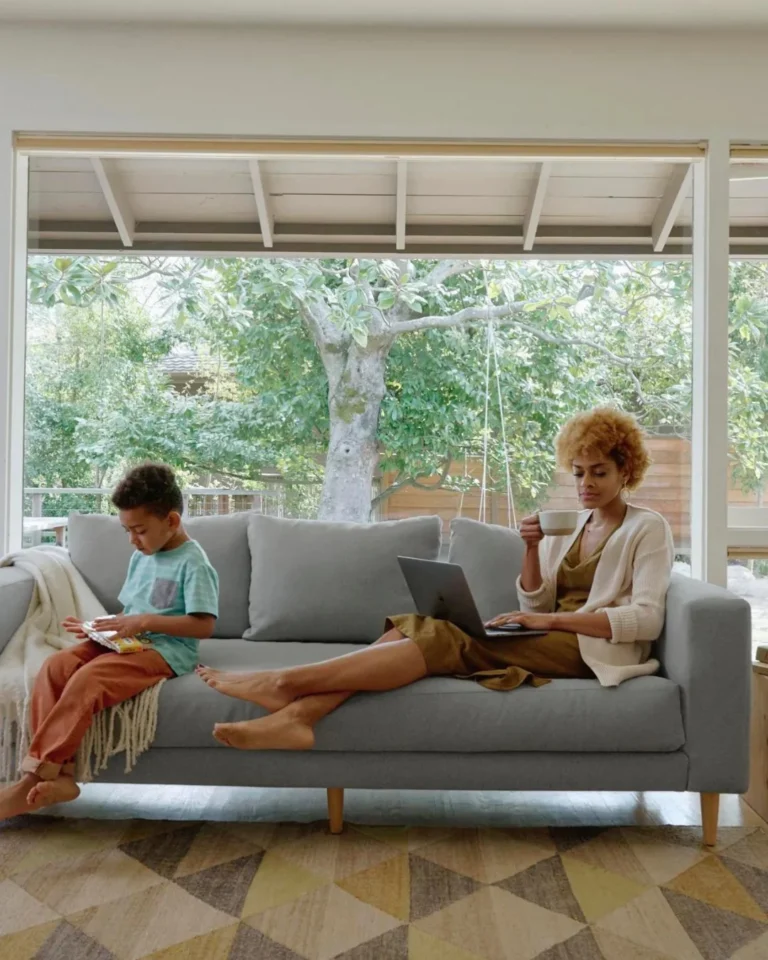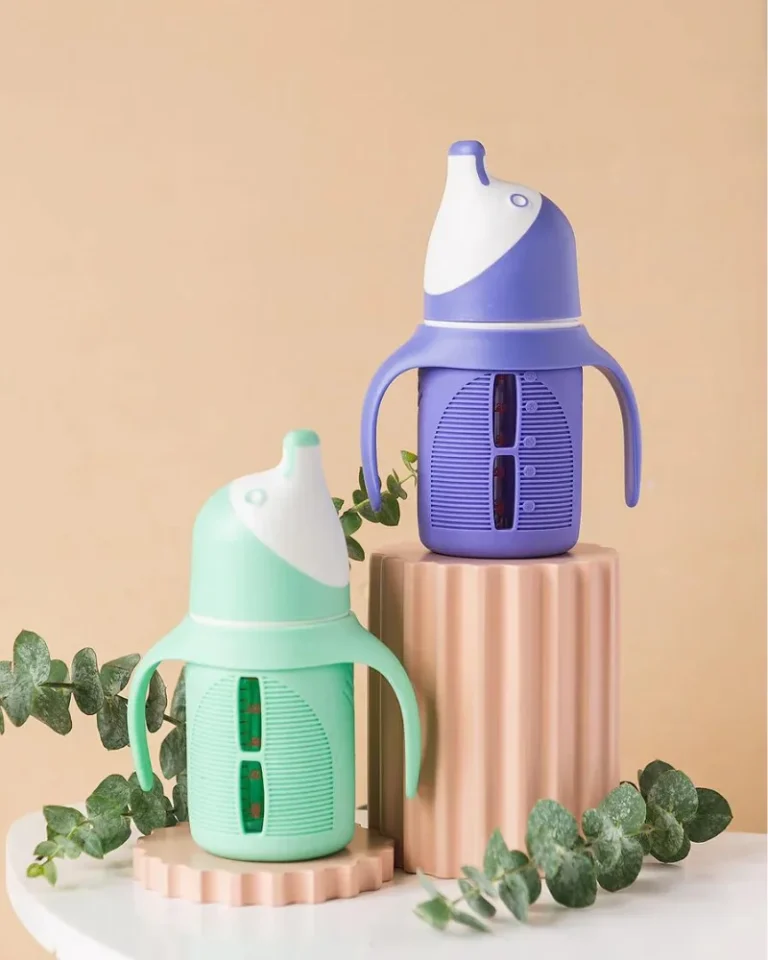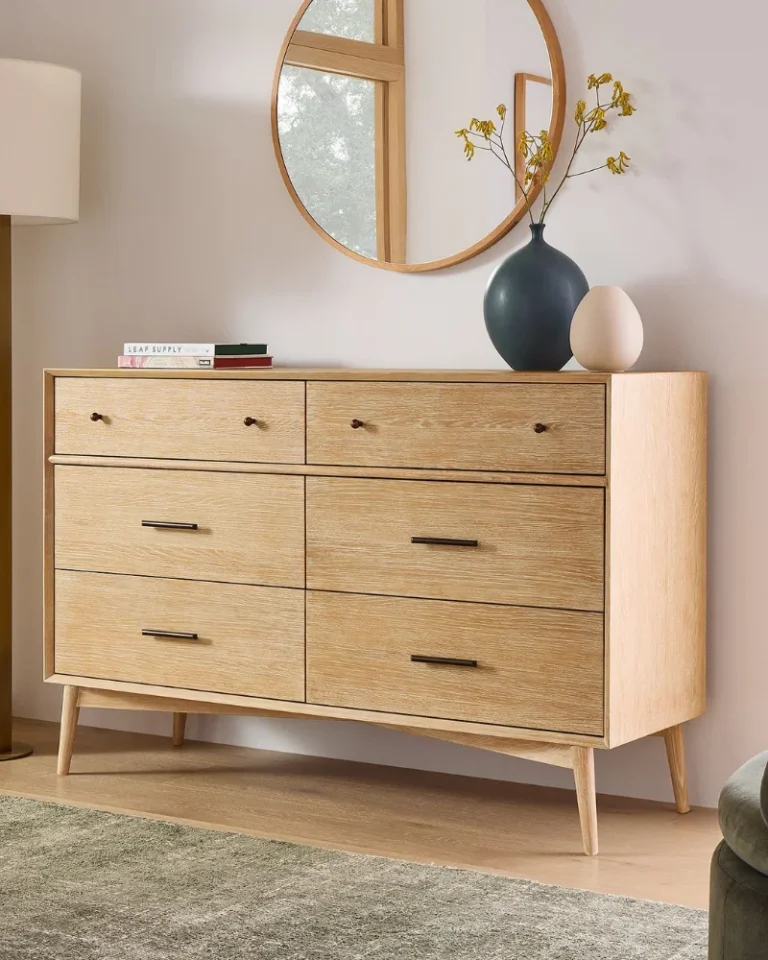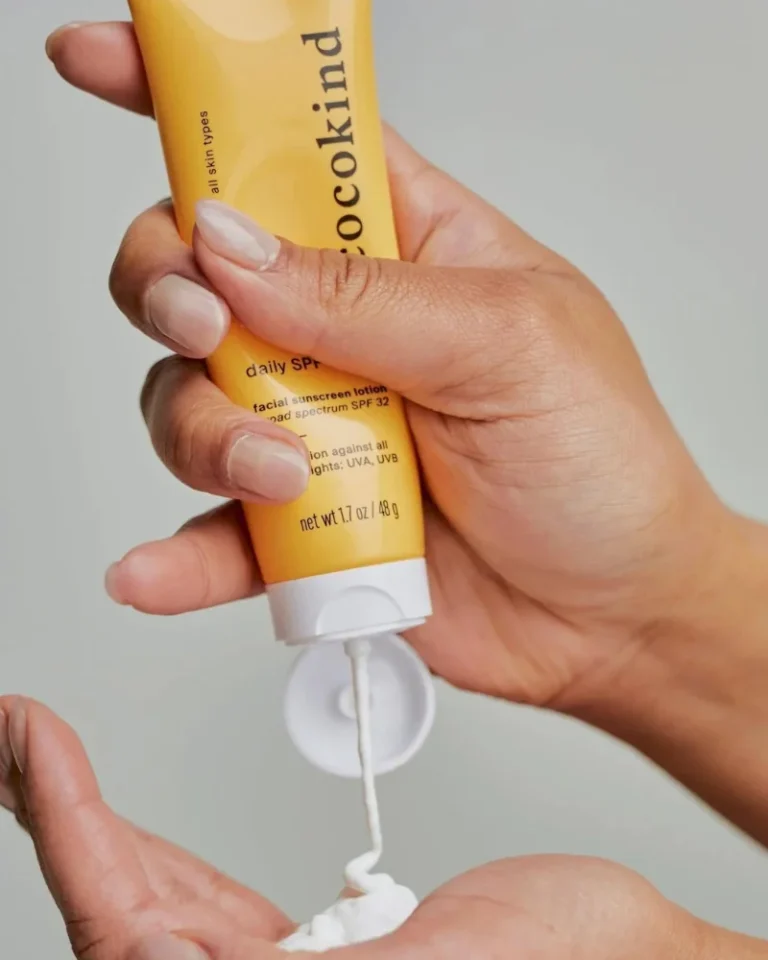This post may contain affiliate links. By browsing this website, you agree to our disclaimer, privacy policy, and terms of use.
Are you looking for the best non-toxic flooring materials? We’re glad you’ve found your way to this article!
We know that building a new home or renovating an existing one can be overwhelming, especially when it comes to choosing materials that are both safe and healthy. It’s difficult to find materials that won’t introduce toxins into your living space.
You’ve trusted the TFC team to bring you the best, low- and no- VOC paints, non-toxic furniture finishes, and eco-friendly home insulation materials. To help you make the best flooring choices for your home, we’ve created this comprehensive list of the top non-toxic flooring options.
You may not think about it often, but the floors beneath your feet can play a crucial role in creating a healthy home.
Many of the conventional flooring options we have in our homes including carpets, vinyl, and laminate, contain volatile organic compounds (VOCs) and other harmful chemicals.
These toxins can silently seep into your home’s air, posing a serious threat to your health and the well-being of your loved ones.
Children, the elderly, and those with respiratory conditions are especially vulnerable to the adverse effects of these toxic chemicals.
Studies have linked them to a range of health problems, from everyday nuisances like headaches and allergies to long-term health concerns like liver damage, kidney problems, and even cancer.
But there’s good news! A rising wave of awareness has fueled the demand for non-toxic, eco-friendly flooring options that prioritize the health of both people and the planet.
These innovative materials offer a stylish, sustainable, and most importantly, safe alternative for your home.
In this article, we’ll delve into the world of non-toxic flooring, exploring seven of the best non-toxic flooring materials and discussing their unique benefits, considerations, and suitability for different areas of your home.
Whether you’re renovating an existing space or building a new home from scratch, these materials offer a range of stylish and sustainable solutions for every room of your home.
Top 7 Non-Toxic Flooring Materials In 2024
1. Cork
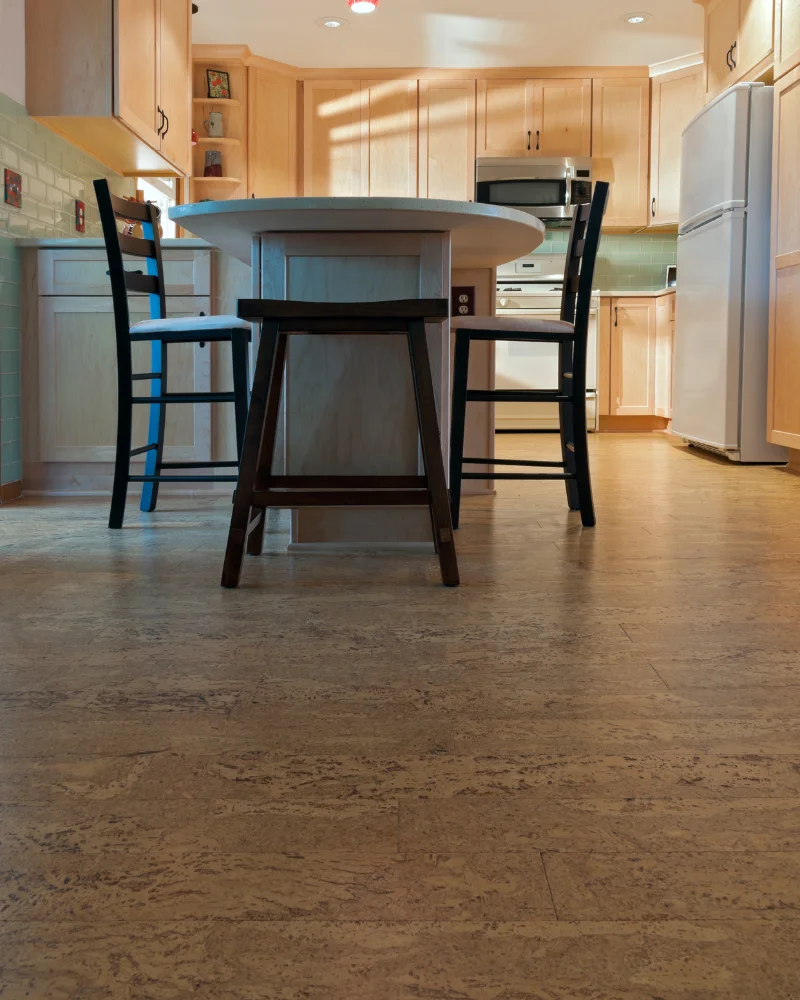
If you’re looking for a non-toxic flooring option that combines comfort, and sustainability, and won’t cause health issues, cork is definitely worth considering.
Harvested from the bark of cork oak trees it has a range of properties that make it an excellent choice for creating a healthy and inviting living space.
Warmth, Comfort, and Sound Insulation
One of the most appealing aspects of cork flooring is its ability to provide warmth and comfort underfoot. Its natural insulating properties help regulate floor temperature, keeping it cool in the summer and warm in the winter.
It’s also an especially cozy choice for bedrooms and living rooms where you want to create a welcoming atmosphere. It’s also great for children’s playrooms. It’s durable withstanding lots of wear and tear while also helping to cushion accidental falls.
In addition to its thermal insulation, cork also offers excellent sound insulation. Its soft, spongy texture helps absorb noise and reduce echo, creating a more peaceful and quiet environment. Another great bonus for playrooms!
Sustainability and Renewability
Cork is not only a non-toxic flooring option but also an eco-friendly choice. The process of harvesting cork bark does not harm the tree, and the bark regenerates every nine years, making it a renewable resource.
Hypoallergenic and Antimicrobial Properties
If you or anyone in your family has allergies or sensitivities, cork is an excellent non-toxic flooring option.
It is naturally hypoallergenic, resistant to dust and mites, and does not absorb dust or pollen like some other flooring materials. This means that cork can help maintain better indoor air quality and reduce allergy symptoms.
Cork also has antimicrobial properties, so it inhibits the growth of bacteria, mold, and mildew. This is especially beneficial in areas prone to moisture, such as bathrooms or kitchens.
Considerations
While cork offers many benefits, it’s essential to consider its potential limitations. Cork is a relatively soft material, meaning it can be prone to dents and scratches from heavy furniture or sharp objects.
- Cost: $$
- Material Source: Bark of cork oak trees (renewable)
- Drawbacks/Considerations: Prone to dents and scratches, sensitive to moisture, professional installation recommended.
- DIY Friendly: No, due to the specific techniques and adhesives required.
- Notable Features: Excellent thermal and acoustic insulation, Naturally hypoallergenic and antimicrobial, Eco-friendly and sustainable
2. Bamboo
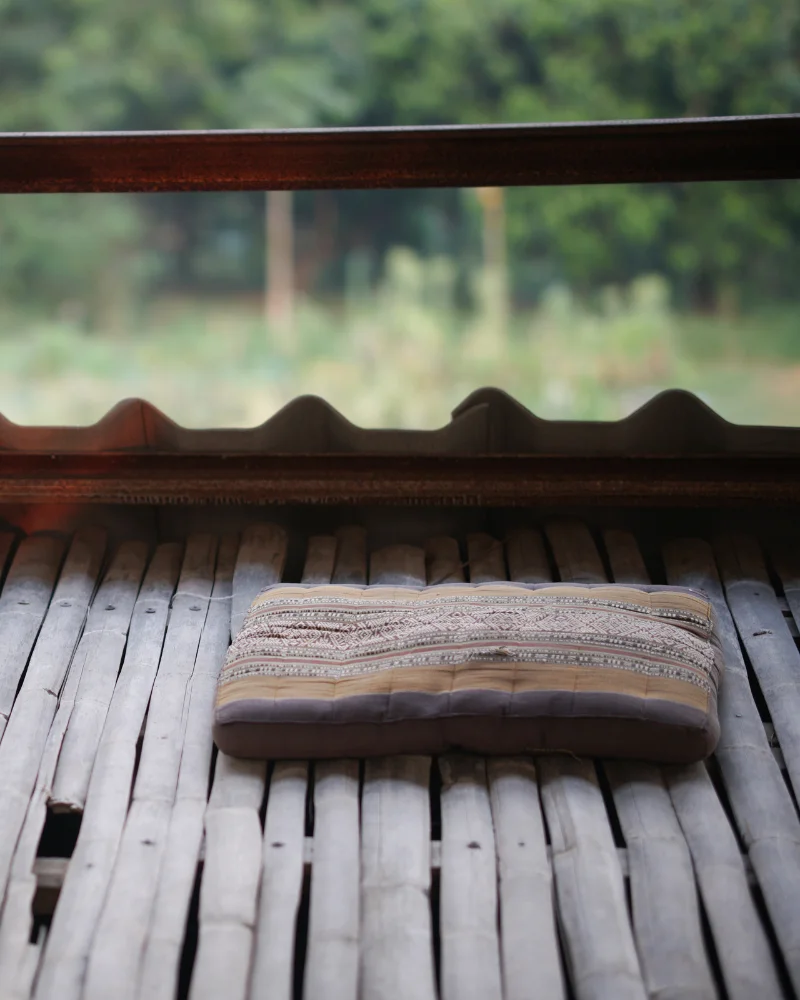
Bamboo has gained popularity as a non-toxic flooring material in recent years, and for good reason. It offers a great combination of environmental friendliness, durability, and style.
Fast Growth and Carbon Sequestration
One of the biggest advantages of bamboo flooring is its environmental friendliness. Bamboo is a fast-growing tree that can be harvested every 3-5 years without damaging the plant or surrounding ecosystem.
This rapid growth makes bamboo a highly renewable resource compared to traditional hardwoods, which can take decades to mature.
In addition to its quick regeneration, bamboo is also an excellent carbon sequestrator. A carbon sequestrator is anything that absorbs more carbon from the atmosphere than it releases, effectively removing carbon dioxide (CO2) from the air.
This is an important process in mitigating climate change as CO2 is a major greenhouse gas contributing to global warming.
As it grows, bamboo absorbs carbon dioxide from the atmosphere, helping mitigate the effects of climate change.
When you choose bamboo flooring, you can contribute to a more sustainable future while reducing your home’s carbon footprint.
A Good Hardwood Alternative
Bamboo flooring offers durability and aesthetic appeal similar to that of hardwood. When properly processed and finished, bamboo can be as strong and long-lasting as traditional hardwood floors too.
Its natural grain patterns and warm tones create a beautiful and inviting atmosphere in any room.
Solid vs. Engineered
When shopping for bamboo flooring, you’ll encounter two main types: solid and engineered.
Solid bamboo flooring is made entirely from bamboo stalks that are sliced, processed, and laminated together. Solid bamboo is going to be your less toxic option of the two.
This type of flooring is suitable for installation over plywood or concrete subfloors and can be refinished multiple times throughout its lifespan.
Engineered bamboo flooring, on the other hand, consists of a thin layer of bamboo veneer bonded to a core of cross-laminated plywood or fiberboard.
Engineered bamboo flooring consists of a thin layer of bamboo on top of plywood or high-density fiberboard (HDF).
Engineered bamboo can be installed as a floating floor over various subfloors, including concrete, plywood, and even existing flooring.
While engineered bamboo flooring is more stable and less susceptible to humidity changes than solid bamboo due to its construction, the core layers used in engineered bamboo can sometimes contain higher levels of VOCs or formaldehyde.
Considerations
Some bamboo flooring products may be harder than others, depending on the manufacturing process. Harder bamboo can be more resistant to dents and scratches but may also be more difficult to cut and install.
Like other natural materials, bamboo is susceptible to moisture damage. It’s crucial to clean up spills promptly and avoid installing bamboo in areas with high humidity or potential water exposure, such as bathrooms or basements.
Given its durability and aesthetic appeal, bamboo flooring is best suited for living areas, bedrooms, and hallways where it can showcase its natural beauty while withstanding daily wear and tear.
- Cost: $$
- Material Source: Bamboo grass (fast-growing and renewable)
- Drawbacks/Considerations: Can be susceptible to moisture damage, hardness varies between products, and some engineered bamboo may contain VOCs.
- DIY Friendly: Yes, for floating floors; professional installation is recommended for nail or glue-down methods.
- Notable Features: Durable and aesthetically similar to hardwood, Fast-growing and sustainable resource, Good for reducing your carbon footprint
3. Natural Linoleum
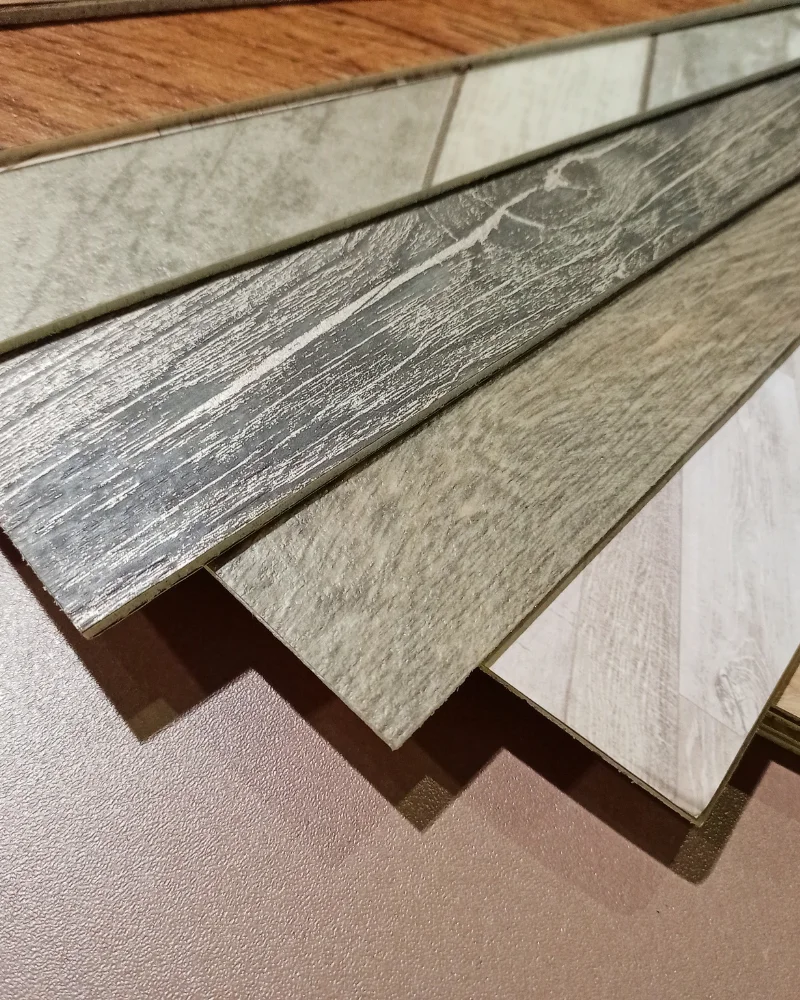
Linoleum has been around for over a century, but its unique composition and environmental benefits have made it increasingly popular among homeowners seeking a healthier flooring option for their homes.
Real linoleum (not to be confused with synthetic versions or vinyl flooring) is made from all-natural materials, including wood flour, rosins, ground limestone, powdered cork, pigments, jute, and linseed oil.
Natural linoleum offers a vast array of design possibilities, making it a popular choice for those looking to create an eye-catching space in their home.
A Blend of Natural Materials
Natural linoleum is made from a combination of linseed oil, wood flour, cork dust, limestone, and natural pigments, all of which are pressed onto a jute or canvas backing.
Linseed oil, the primary ingredient in natural linoleum, is derived from flax seeds and acts as a natural binding agent.
Wood flour and cork dust provide a sturdy and resilient surface, while limestone helps to make the material more fire-resistant.
The natural pigments used in linoleum allow for a wide range of colors and patterns without the need for harmful chemical dyes.
This blend of natural materials is not only non-toxic but also biodegradable and environmentally friendly.
Biodegradable and Renewable
Unlike synthetic flooring options that can take centuries to decompose in landfills, linoleum is biodegradable. When it reaches the end of its life cycle, it can break down naturally without releasing harmful toxins into the environment.
Additionally, the materials used in natural linoleum are renewable and sustainably sourced.
Linseed oil is derived from flax plants, which can be grown and harvested annually, while wood flour and cork dust come from responsibly managed forests.
By choosing natural linoleum, you can reduce your environmental impact and contribute to a greener future.
Versatile Design Options
The natural pigments used in linoleum allow for a wide spectrum of colors, from subtle neutrals to bold and vibrant hues.
Additionally, linoleum can be cut and arranged in various patterns, including geometric shapes, intricate designs, and custom logos or graphics.
This versatility makes natural linoleum an excellent option for both residential and commercial settings, as it can be tailored to suit any aesthetic preference or design style.
Durability and Longevity
Natural linoleum is known for its durability and longevity. When properly installed and maintained, linoleum flooring can last for decades, making it a cost-effective and long-term investment for your home.
The natural materials used in linoleum create a resilient surface that can withstand heavy foot traffic, spills, and minor impacts without cracking or breaking.
Its smooth, non-porous surface is easy to clean and resistant to dust, dirt, and allergens, making it an ideal choice for those with allergies or respiratory sensitivities.
Considerations
While natural linoleum offers many benefits, it’s important to consider the installation process.
Linoleum installation can be more complex than other flooring options. It is recommended to hire a professional installer to ensure the best results.
Proper installation is necessary to prevent moisture damage and ensure a seamless finish.
Given its durability, water resistance, and easy maintenance, natural linoleum is best suited for high-traffic areas such as kitchens, bathrooms, and entryways.
When selecting natural linoleum, look for products that are certified by environmental organizations to ensure they meet the highest standards for indoor air quality and environmental impact.
- Cost: $$$
- Material Source: Linseed oil, wood flour, cork dust, limestone, natural pigments (renewable and biodegradable)
- Drawbacks/Considerations: Professional installation is highly recommended, not as moisture-resistant as some other options.
- DIY Friendly: No, due to the complexity of installation and the need for specific tools and adhesives.
- Notable Features: Wide variety of colors and patterns, Biodegradable and eco-friendly, Durable and long-lasting
4. Solid Hardwood
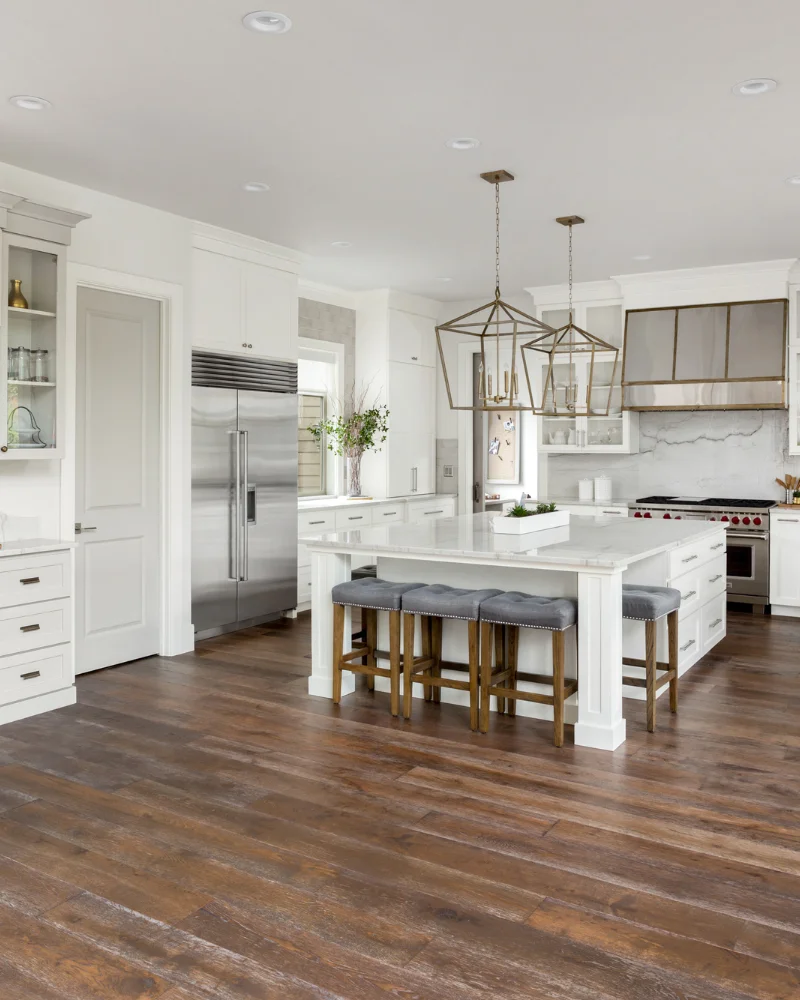
Solid hardwood flooring is a beautiful, durable, and environmentally friendly choice that can enhance the look and feel of your home.
Solid hardwood’s natural beauty, resilience, and contribution to healthier indoor air quality make it a timeless choice for creating a warm and inviting living space.
Warmth, Beauty, and Natural Variations
One of the most appealing aspects of solid hardwood flooring is its ability to bring warmth to any room.
The rich tones and unique grain patterns of woods like oak, maple, hickory, and walnut add depth and character to your home, creating an inviting atmosphere that is both classic and contemporary.
Unlike synthetic flooring options, solid hardwood showcases the natural variations that come with real wood. Each plank is unique, with its own distinct knots, mineral streaks, and grain patterns, in a way that feels charming and authentic.
The Importance of FSC Certification
When choosing solid hardwood flooring, it’s a good idea to look for products that are certified by the Forest Stewardship Council (FSC).
FSC certification guarantees that the forestry practices used are environmentally sound, socially responsible, and economically viable.
By choosing FSC-certified solid hardwood, you can feel confident that your flooring is not contributing to deforestation, habitat destruction, or other harmful environmental practices.
Health Benefits
While solid hardwood itself is a non-toxic and natural material, it’s important to consider the finishes used to protect and enhance its beauty.
Traditional hardwood finishes often contain volatile organic compounds (VOCs) that can off-gas into your living space, potentially compromising indoor air quality and triggering health issues like respiratory irritation or allergic reactions.
Fortunately, there are now many low-VOC and zero-VOC finishes available that provide the same level of protection as traditional finishes without harmful emissions.
When selecting your solid hardwood flooring, opt for products that use these healthier finishes for completely non-toxic flooring.
Considerations
Solid hardwood can be pricier than other flooring options. It also requires regular maintenance, such as sweeping, vacuuming, and occasional refinishing, to keep it looking its best.
Hardwood is also susceptible to scratches and dents from heavy furniture or sharp objects, so it may not be the best choice for households with large pets or active children.
In terms of placement, solid hardwood flooring is best suited for living areas and bedrooms. However, it is not a good option for high-moisture areas like bathrooms or basements, as excessive humidity can cause the wood to over time.
- Cost: $$$-$$$$$
- Material Source: Various tree species (can be sustainably sourced with FSC certification)
- Drawbacks/Considerations: Requires regular maintenance, susceptible to scratches and dents, not ideal for high-moisture areas.
- DIY Friendly: Possible for experienced DIYers with the right tools, but professional installation is often preferred for the best results.
- Notable Features: Timeless natural beauty and warmth, Will last for years and can be refinished multiple times, Can improve indoor air quality with low-VOC finishes
5. Natural Stone
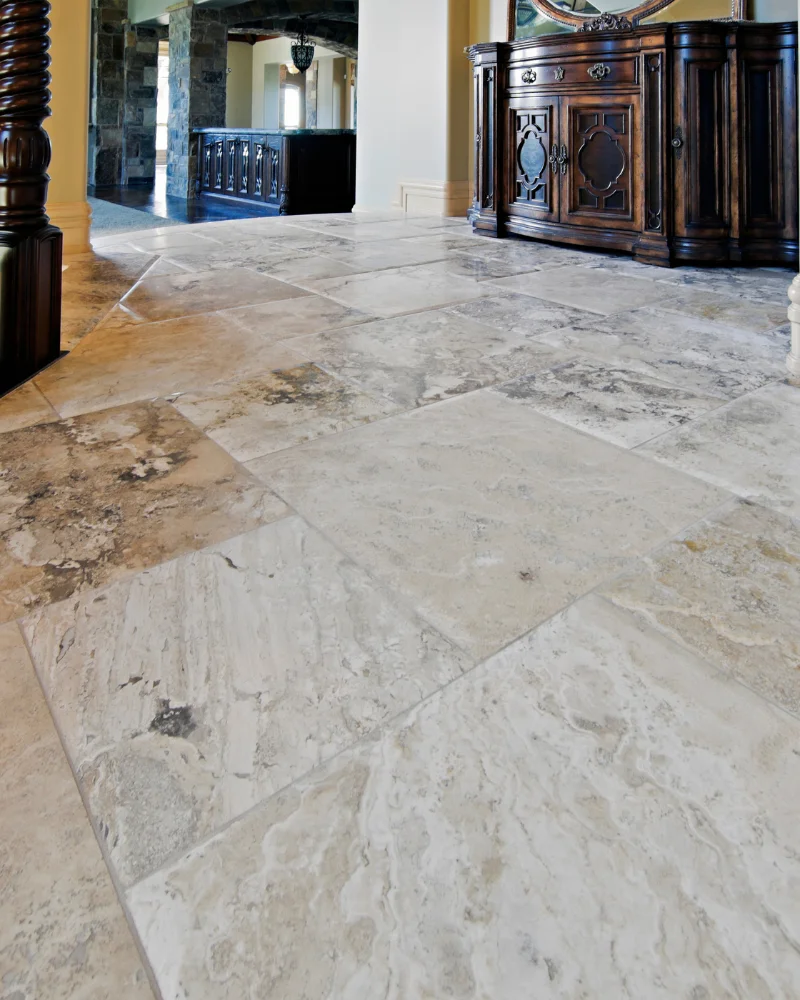
Natural stone flooring has been used for its timeless beauty and durability for centuries.
From ancient palaces to modern homes, natural stone has proven itself to be a non-toxic and long-lasting flooring option that adds sophistication to your home.
Of course, this stunning flooring option doesn’t come cheap! And it can sometimes feel cold and uninviting depending on the type of home you live in.
Marble, Slate, Granite, and More
Natural stone flooring comes in a wide variety of types, each with its own unique characteristics and aesthetic appeal. Some popular options include:
- Marble: Known for its luxurious appearance and distinctive veining, marble is a classic choice for high-end spaces like foyers, bathrooms, and fireplace surrounds.
- Slate: With its rustic, textured surface and earthy color palette, slate is a durable and slip-resistant option that works well in kitchens, bathrooms, and outdoor areas.
- Granite: Prized for its strength and resistance to scratches and stains, granite offers a wide range of colors and patterns that can complement any design style.
- Travertine: This porous limestone is characterized by its natural pits and voids, creating a rustic and organic look that is perfect for Mediterranean or Tuscan-inspired homes.
- Limestone: Soft and porous, limestone offers a warm and inviting appearance that improves with age, developing a beautiful patina over time.
Benefits of Natural Stone
One of the primary benefits of natural stone flooring is its exceptional durability. When properly sealed and maintained, natural stone can last for decades, withstanding heavy foot traffic.
This longevity makes it a cost-effective and practical choice for high-traffic areas like kitchens, bathrooms, and entryways.
In addition to its durability, natural stone flooring offers a one-of-a-kind aesthetic that cannot be replicated by synthetic materials.
Each piece of stone is unique, with its own distinct patterns, colors, and veining. This natural variation ensures that your flooring is a unique work of art.
Another advantage of natural stone is its heat resistance. Unlike some synthetic flooring options that can warp or melt under high temperatures, natural stone is naturally heat-resistant, making it an ideal choice for spaces with fireplaces, stoves, or radiant under-floor heating systems.
Local Sourcing and Responsible Quarrying
When selecting natural stone flooring you’ll want to consider the environmental impact of your choice.
One way to minimize your carbon footprint is to choose locally sourced stone whenever possible.
By reducing the distance the stone must travel from the quarry to your home, you can significantly reduce the energy consumption and emissions associated with transportation.
Look for stone suppliers that adhere to strict environmental regulations and prioritize sustainable extraction methods.
This ensures that the natural habitats surrounding the quarry are protected and that the stone is harvested in a way that minimizes waste and damage to the environment.
Considerations
Natural stone can be more expensive than other flooring options. Its hardness can make it feel cold underfoot and can be noisy without proper soundproofing.
Also, some types of stone, like marble and limestone, are more porous and susceptible to staining if not properly sealed and maintained.
Its water-resistant properties make it an excellent choice for spaces prone to moisture, while its aesthetic versatility allows it to complement a wide range of design styles, from classic to contemporary.
- Cost: $$$$-$$$$$
- Material Source: Quarried stone (can be locally sourced)
- Drawbacks/Considerations: Expensive, can be cold and hard, and some types are porous and require sealing.
- DIY Friendly: No, professional installation is highly recommended due to the weight and complexity of working with stone.
- Notable Features: Unique and timeless beauty, Extremely durable and long-lasting, Heat-resistant
6. Ceramic Tile
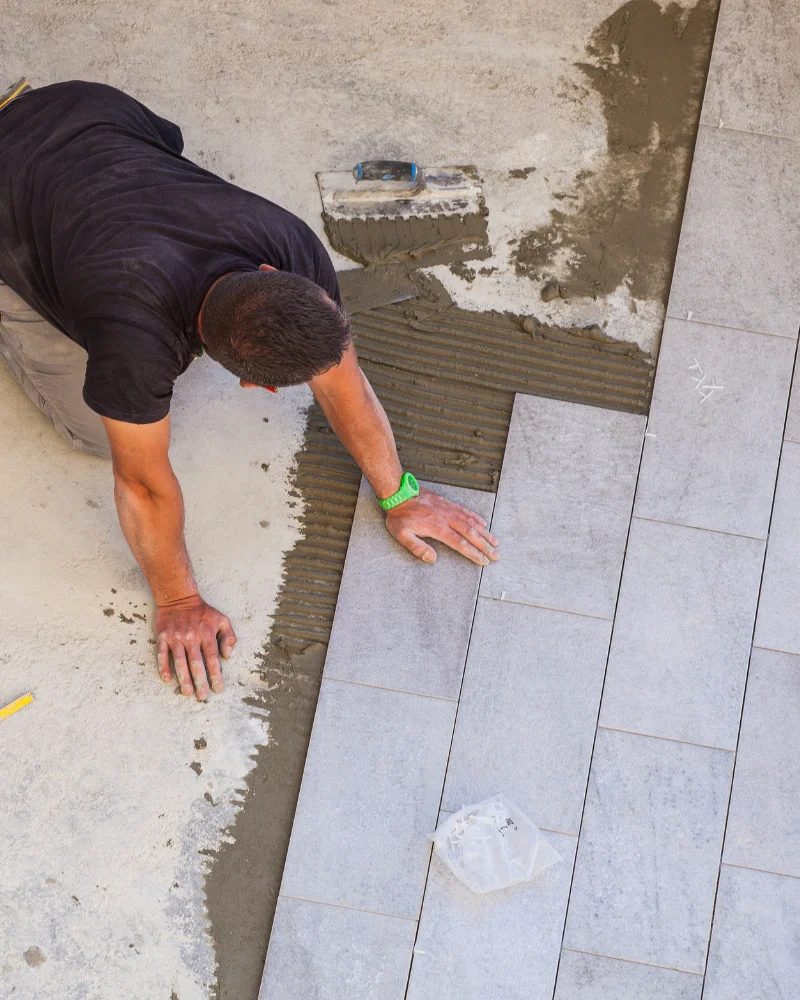
With the variety of types, colors, and styles available, tile flooring provides a practical and stylish solution for creating a beautiful and healthy home. It’s durable, versatile, and easy to maintain.
Ceramic, Porcelain, and Recycled Glass
Tile flooring comes in several distinct types, each with its own unique properties and benefits:
- Ceramic: Made from clay and other natural materials, ceramic tiles are fired at high temperatures to create a water-resistant surface. They come in a variety of colors, patterns, and finishes, making them a popular choice for both indoor and outdoor applications.
- Porcelain: A denser and less porous type of ceramic tile, porcelain is known for its exceptional strength and water resistance. Porcelain tiles are fired at even higher temperatures than ceramic, resulting in a more long-lasting flooring option. They are ideal for high-traffic areas and spaces prone to moisture, like bathrooms and kitchens.
- Recycled Glass: For an eco-friendly and visually striking option, consider recycled glass tiles. Made from post-consumer and industrial glass waste, these tiles offer a unique and luminous appearance while diverting materials from landfills. They are durable, stain-resistant, and available in a wide range of colors and styles.
Versatile Design Options and Low Maintenance
Tile also offers a lot in terms of versatile design options. From classic hexagons to intricate mosaics, tiles come in an endless array of colors, patterns, and styles to suit any aesthetic preference.
Whether you’re looking to create a sleek and modern look or a warm and rustic feel, there’s a tile option to match your vision.
Both ceramic and porcelain tiles are resistant to scratches, stains, and moisture, making them a practical choice for high-traffic areas and households with pets or children. When properly installed and maintained, tile flooring can last for decades.
Ceramic tiles are incredibly easy to clean and disinfect with simple household cleaners, helping to maintain a healthy environment. This is particularly important in kitchens and bathrooms where hygiene is crucial.
Health Benefits
Ceramic tiles are made from natural materials like clay and minerals, which are fired at high temperatures.
This process eliminates any volatile organic compounds (VOCs) or other harmful chemicals that could off-gas into your home’s air.
Unlike carpet or hardwood, tiles are easy to clean and disinfect, requiring only regular sweeping, mopping, and occasional sealing to maintain their appearance and functionality.
This makes them an ideal choice for households with allergies or sensitivities, as they don’t harbor dust mites, allergens, or other irritating particles.
The non-porous nature of ceramic tiles also makes them resistant to mold and mildew growth, which can exacerbate allergies and asthma.
Recycled Content, Local Production, and Long Lifespan
Many tiles are made with recycled materials, such as post-consumer glass or industrial waste, which helps reduce the environmental impact of production.
By choosing tiles with recycled content, you can contribute to a more sustainable and circular economy.
Another way to minimize your environmental footprint is to choose locally produced tiles whenever possible.
By reducing the distance the tiles must travel from the manufacturer to your home, you can significantly reduce the energy consumption and emissions associated with transportation.
Considerations
Tiles can feel cold and hard underfoot, which may be uncomfortable in colder climates or for those with joint pain.
However, you can get around this issue by installing radiant floor heating beneath the tiles, which provides a warm and cozy surface to walk on.
Another consideration is the installation process, which requires professional expertise to ensure a level and properly sealed surface. DIY installation can cause uneven or poorly spaced tiles, which can compromise the flooring’s durability.
In terms of cost, tile flooring can be more expensive than some other options, particularly if you opt for high-end materials or intricate designs.
However, the long-term durability and low maintenance requirements of tile can make it a cost-effective choice in the long run.
Given its water resistance, durability, and easy maintenance, tile flooring is best suited for kitchens, bathrooms, and other high-traffic areas prone to moisture.
- Cost: $$
- Material Source: Clay, minerals, recycled glass (some options are made with recycled content)
- Drawbacks/Considerations: Can be cold and hard, professional installation is recommended, and grout lines require maintenance.
- DIY Friendly: Possible for simple installations, but professional installation is recommended for complex patterns or large areas.
- Notable Features: Wide variety of colors, patterns, and styles, Durable, water-resistant, and easy to clean, Can be made with recycled materials
7. Polished Concrete
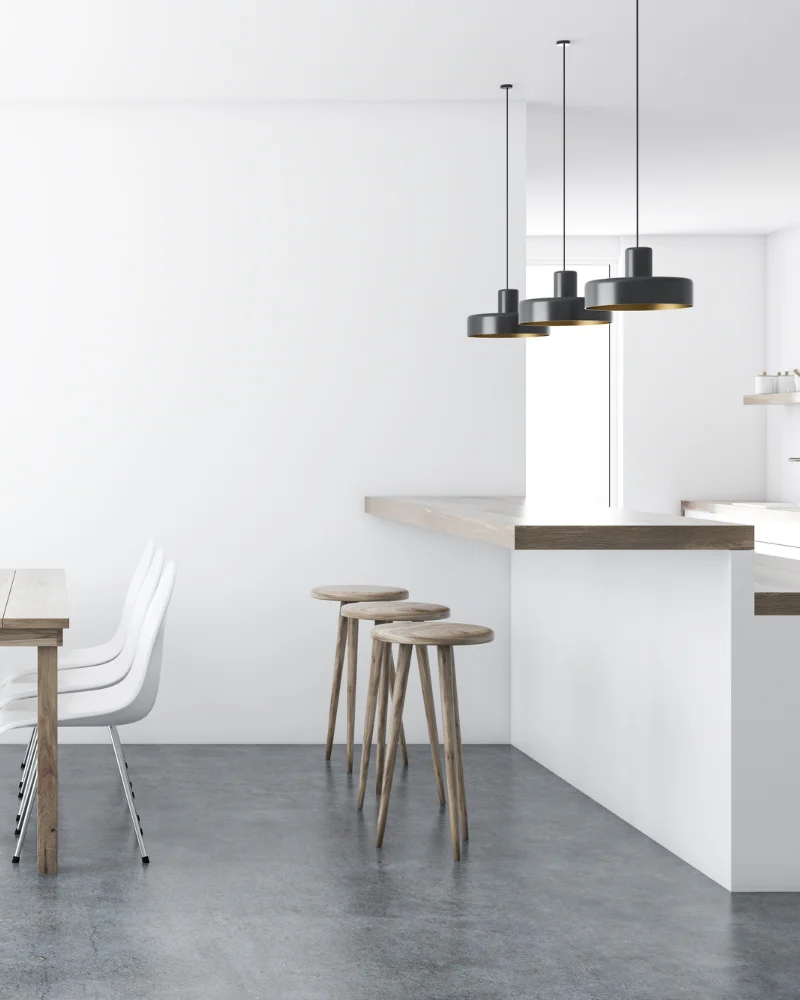
In the world of non-toxic flooring options, polished concrete has emerged as a popular choice for its sleek, modern appearance and easy upkeep.
Polished concrete is created by grinding and polishing an existing concrete slab to achieve a smooth, even surface.
This multi-step process uses specialized equipment and diamond abrasives to remove imperfections and create a polished finish.
Low Maintenance and Ultra- Durable
Nothing is more durable than polished concrete. The hardening process that occurs during polishing makes the concrete extremely resistant to wear and tear, scratches, and stains.
This durability translates to a low-maintenance flooring option. Polished concrete doesn’t need waxing or sealing like other flooring materials. Regular sweeping and occasional damp mopping is usually sufficient to keep the surface clean and looking its best.
Modern Aesthetic
Polished concrete has a sleek industrial look that has become increasingly popular in contemporary design. Its minimalist appearance can complement a wide range of architectural styles and interior design schemes.
The reflective properties of polished concrete can help brighten a space and reduce the need for artificial lighting, creating a more open and inviting atmosphere.
Of course, polished concrete isn’t an aesthetic that will fit all homes, especially if you live in a farmhouse, colonial, or more traditional home. And while it is durable, it can be hard and unforgiving, especially to little ones who are prone to slips and falls.
Health Benefits
Polished concrete is an excellent choice for those with allergies or respiratory sensitivities. The smooth, sealed surface of polished concrete doesn’t trap dust, pollen, or other allergens, making it hypoallergenic.
Polished concrete also doesn’t emit volatile organic compounds (VOCs) or other harmful chemicals.
The non-porous nature of polished concrete makes it inherently resistant to mold and mildew growth. This property is particularly beneficial in areas prone to moisture, like basements or bathrooms.
An Eco-Friendly Option
Polished concrete is an eco-friendly flooring option. It has a long lifespan and conserves resources by utilizing the existing concrete slab, eliminating the need for new materials.
This reduces the environmental impact associated with production and transportation. With proper maintenance, polished concrete can last for decades, further reducing its environmental footprint.
Considerations
The hardness of concrete can make it uncomfortable to stand on for extended periods, and it may feel cold underfoot without radiant heating. Polished concrete can also be slippery when wet, so it may not be suitable for areas prone to spills.
Noise can be another concern, as concrete doesn’t absorb sound as effectively as some other flooring materials.
Professional installation is also necessary, as the process requires specialized equipment and expertise to achieve the desired results.
Polished concrete is best suited for modern and industrial spaces, such as lofts, open floor plans, and commercial settings.
It works particularly well with radiant heating systems embedded in the concrete, providing both comfort and energy efficiency.
- Cost: $$$
- Material Source: Existing concrete slab (can be considered sustainable due to reuse)
- Drawbacks/Considerations: Hard and cold, can be slippery when wet, professional installation required.
- DIY Friendly: No, the polishing process requires specialized equipment and expertise.
- Notable Features: Sleek and modern appearance, Extremely durable and low-maintenance, Non-toxic and hypoallergenic
This has been your comprehensive guide to the best non-toxic flooring materials for a healthier home!
Selecting the right non-toxic flooring material for your home is a decision that goes beyond aesthetics. It’s an investment in your family’s health, your home’s value, and the planet’s future.
With the right non-toxic flooring material underfoot, you can create a beautiful, welcoming, and environmentally responsible home that you and your family will enjoy for years to come.
Every choice we make in our homes, no matter how small, has the power to make a positive impact on the world around us.
So, whether you’re renovating a cherished family home or starting fresh in a new space, let your flooring choice reflect your values and your vision for a healthier, more sustainable way of living.
